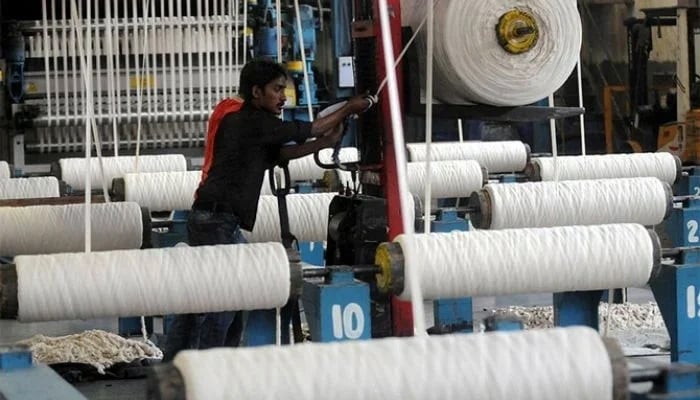Garment sector faces pressure from rising energy costs, IMF programme: PACRA
KARACHI: The garment sector, a key contributor to the country's exports and GDP, is facing pressure from rising gas prices and the removal of energy subsidies under the International Monetary Fund (IMF) programme, a rating agency said.
Pakistan Credit Rating Agency (PACRA) said in its latest study on the garment sector that the recent gas tariff hike of November 2023, which increased the cost of gas to $10.3 per million British thermal units (MMBTU), the highest among regional competitors, would adversely affect the sector's margins and competitiveness.
“The removal of subsidies under the IMF directives is likely to render exports non-competitive in the international market.. garments sector’s margins are expected to rangebound, owing to domestic factors like higher expected cotton production during FY24, stable interest rates and consistent demand, both locally as well as globally, with global economic activity to rebound," PACRA said, adding that the impact of the gas tariff hike was yet to unfold.
Pakistan entered a $3 billion IMF standby programme in July 2023 to avert a balance of payments crisis and agreed to implement structural reforms, including raising energy tariffs, broadening the tax base and reducing fiscal deficits. The garment sector, which includes textiles, clothing and leather products, contributed 3.0% to the country's GDP in fiscal year 2023, reaching a market size of Rs2.6 trillion, up 8.0 percent year-on-year.
However, textile exports, which accounted for 59 percentof the country's total exports, declined by 14.6 percent in fiscal year 2023, due to supply chain disruptions caused by import restrictions imposed by the central bank and flash floods in August 2022. Textile imports also fell by 21.8% in fiscal year 2023, as the central bank restricted the import of raw materials and machinery to conserve foreign exchange reserves.
The garment sector is dominated by 59 organized composite units, with 32 listed on the Pakistan Stock Exchange (PSX), PACRA said.
The rating agency said the sector's margins were expected to remain rangebound, owing to domestic factors such as higher expected cotton production in fiscal year 2024, stable interest rates and consistent demand, both locally and globally, with global economic activity expected to rebound.
The local textile sector is classified as a Large Scale Manufacturing (LSM) industrial component within the industrial sector. In FY23, the textile industry’s weight in the QIM was recorded at 18.2 percent. In FY23, despite a 10.7 percent year-on-year increase in cultivation area, cotton yield declined by 45.9 percent due to floods in August 2022, resulting in 41 percent year-on-year decrease in cotton production to 4.9 million bales.
"FY24 target for cotton production is set at 12.7 million bales, while the government announced an incentive in the form of minimum Support Price (MSP) of Rs8,500/40kg bag for the FY24 cotton crop," PACRA said. “The FY23 dip in gross profit margin resulted from increase in cost of sales by 20 percent year-on-year, offsetting the increase in sales... similarly, operating margins remained at 13 percent in FY23 owing to the increase in operating costs (especially the energy costs) which nullified the increase in gross profit." The report said net margins dipped to 7 percent from 9 percent in FY22, owing to higher finance costs which grew by 127 percent year-on-year due to the increase in policy rates during the year.
"As per IMF’s directives, the government withdrew the Regionally Competitive Energy Tariff (RCET) for export-oriented sectors. Moreover, gas prices were revised upwards as of Nov 2023 lowering the competitiveness of Pakistan’s export prices."
-
 NASA Celebrates One Year Of Trump’s Second Term With Moon And Mars Achievements
NASA Celebrates One Year Of Trump’s Second Term With Moon And Mars Achievements -
 Chris Pratt Shares Real Thoughts On AI In Film Industry
Chris Pratt Shares Real Thoughts On AI In Film Industry -
 Netflix Disappointed As Meghan Markle’s Series Struggles To Impress
Netflix Disappointed As Meghan Markle’s Series Struggles To Impress -
 Royal Family Announces Death Of Princess: King Releases Statement
Royal Family Announces Death Of Princess: King Releases Statement -
 Sarah Ferguson Will Continue To Be Part Of Andrew's Life
Sarah Ferguson Will Continue To Be Part Of Andrew's Life -
 Google’s Gemini Now Offers Free SAT Prep With Full-length Mock Tests
Google’s Gemini Now Offers Free SAT Prep With Full-length Mock Tests -
 Everything You Need To Know About Macron’s Viral Glasses: Cost, Model, All Details Revealed
Everything You Need To Know About Macron’s Viral Glasses: Cost, Model, All Details Revealed -
 Elon Musk Warns Of AI ‘supersonic Tsunami’: What It Means For Future
Elon Musk Warns Of AI ‘supersonic Tsunami’: What It Means For Future -
 Why Victoria Beckham's Dance Video From Brooklyn's Wedding Won't Be Released
Why Victoria Beckham's Dance Video From Brooklyn's Wedding Won't Be Released -
 Prince Harry No Longer Focused On Healing Royal Family Feud?
Prince Harry No Longer Focused On Healing Royal Family Feud? -
 OpenAI Aims To Make AI A Daily Global Tool
OpenAI Aims To Make AI A Daily Global Tool -
 Will Andrew Receive Any Royal Treatment After Title, Royal Lodge Removal?
Will Andrew Receive Any Royal Treatment After Title, Royal Lodge Removal? -
 How Your Body 'suffers' In Back Pain And Simple Way To Fix It
How Your Body 'suffers' In Back Pain And Simple Way To Fix It -
 What Victoria Beckham Really Did At Brooklyn, Nicola’s Wedding Revealed
What Victoria Beckham Really Did At Brooklyn, Nicola’s Wedding Revealed -
 Send Your Name To Moon With Nasa’s Artemis Mission: Here’s How
Send Your Name To Moon With Nasa’s Artemis Mission: Here’s How -
 Zhipu AI, MiniMax Debuts Mask Structural Hurdles For China’s Tech Giants
Zhipu AI, MiniMax Debuts Mask Structural Hurdles For China’s Tech Giants




